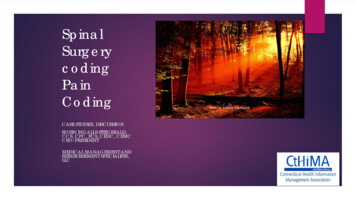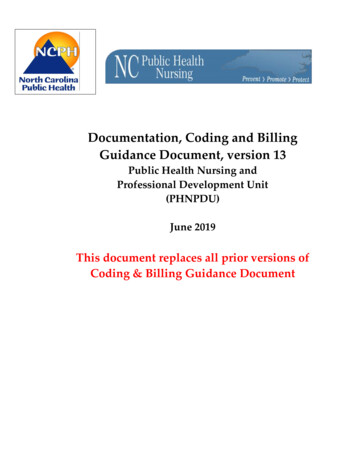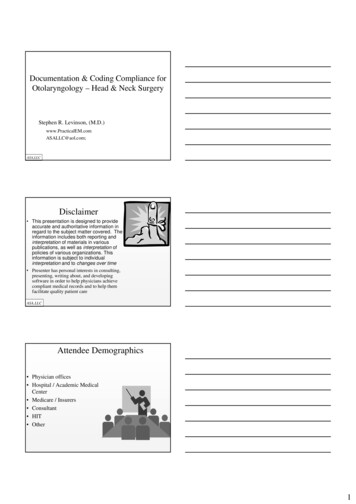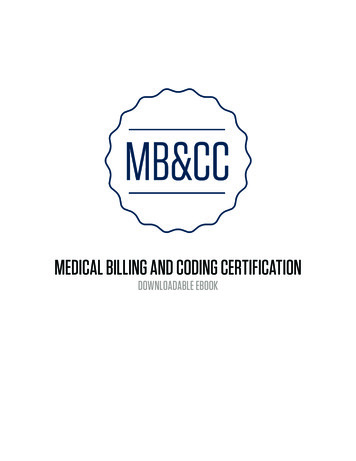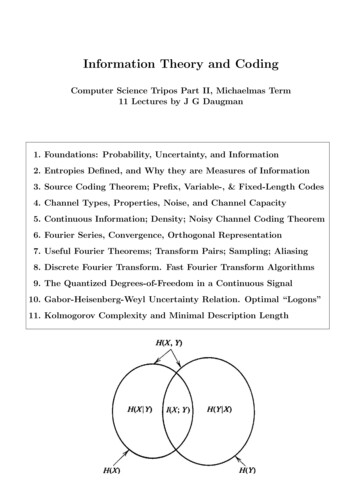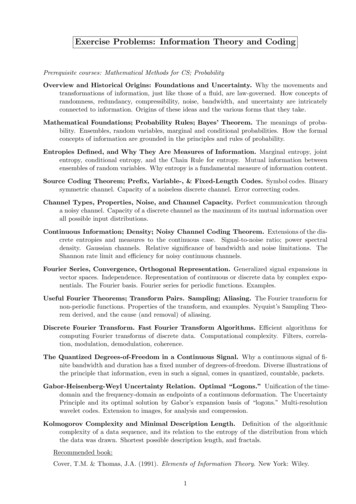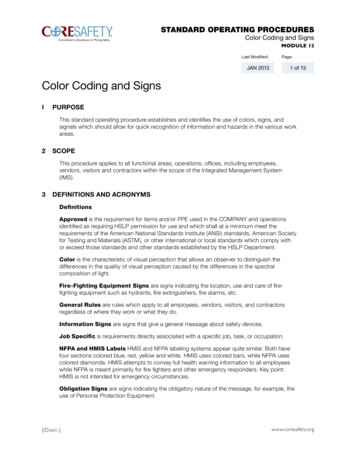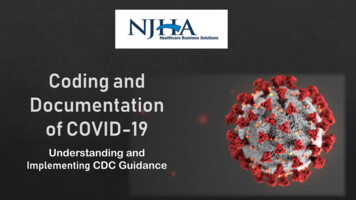
Transcription
Presentation Objectives Learn what NJHA is doing to assist NJ providers in theirresponse efforts. Understand the official diagnosis coding guidance for healthcare encounters and deaths related to the 2019 novelcoronavirus (COVID-19) previously named 2019-nCoV. Implement documentation practices that allow for accuratecoding of COVID-19.
NJHA RESPONSE EFFORTS NJHA’s team of Emergency Preparedness and Clinical Affairsprofessionals are monitoring the 2019 novel Coronavirus (COVID-19), incollaboration with public health agencies. NJHA will begin to sweep the data daily to identify trends and possible hotspots. rus/ This link compiles key guidance and other resources for the healthcareprovider community to support their preparedness and response efforts.NJHA’s Emergency Preparedness office is available 24/7 to healthcareproviders at 1-800-457-2262.
COMPLETE AND PRECISE CODING IS IMPERATIVE FORACCURATE REPORTING OF NJ COVID-19 CASESIDENTIFICATION OF HOT SPOTS AND INFECTIONS RATESARE BASED ON YOUR REPORTED ICD-10 CODESTHE IMPORTANCE OF CONSISTENT ADHERENCE TO THEFOLLOWING GUIDELINES CANNOT BE STRESSEDENOUGH
CDC GUIDANCE ICD-10-CM Official Coding Guidelines - Supplement Coding encountersrelated to COVID-19 Coronavirus Outbreak Effective: February 20, 2020 This guidance is intended to be used in conjunction with the currentICD-10-CM classification and the ICD-10-CM Official Guidelines forCoding and Reporting (effective October 1, 2019) and will be updated toreflect new clinical information as it becomes available. New ICD-10-CM code for the 2019 Novel Coronavirus (COVID-19),October 1, 2020 (U07.1, 2019-nCoV acute respiratory disease)
TYPES OF CORONAVIRUS Coronaviruses are named for the crown-like spikes on their surface. Thereare four main sub-groupings of coronaviruses, known as alpha, beta, gamma,and delta. Common types -229E, NL63, OC43, HKU1 Severe types - MERS-CoV, SARS-CoV , and COVID-19
DOCUMENTATION FOR COVID-19Physician documentation must: Confirm a positive test of COVID-19 Link any associated respiratory conditions Identify that the infection was present on admission Consistently document comorbidities such as acuterespiratory failure, ARDS, COPD exacerbation, PNA, CHF,MI, etc.
CODING COVID-19 Do not code “suspected”, “possible” or “probable” COVID-19. In such cases,Assign a code(s) explaining the reason for encounter Do not use Coronavirus infection, unspecified, for the COVID-19. Caseshave universally been respiratory in nature, so the site would not be“unspecified.” Presumptive positive — A presumptive positive test is for the time betweenan initial positive test for the virus by a public health lab but before thefederal Centers for Disease Control and Prevention has confirmed theresults. A presumptive positive result from a CDC test is treated as if thepatient is positive for the virus, according to the CDC.
CODING COVID-19PneumoniaFor a pneumonia case confirmed as due to the2019 novel coronavirus (COVID-19),assign codesJ12.89, Other viral pneumoniaB97.29, Other coronavirus as the cause ofdiseases classifiedelsewhere.
CODING COVID-19Acute Bronchitis confirmed as due to COVID-19, assign codesJ20.8, Acute bronchitis due to other specified organismsB97.29, Other coronavirus as the cause of diseases classifiedelsewhere.Bronchitis not otherwise specified (NOS) due to the COVID-19assign codesJ40, Bronchitis, not specified as acute or chronicB97.29, Other coronavirus as the cause of diseases classifiedelsewhere.
CODING COVID-19Acute respiratory infection, NOS, associated with COVID-19 assigncodes:J22, Unspecified acute lower respiratory infectionB97.29, Other coronavirus as the cause of diseases classifiedelsewhere.COVID-19 associated with a respiratory infection, NOS, assign codes:J98.8, Other specified respiratory disordersB97.29, Other coronavirus as the cause of diseases classifiedelsewhere.
CODING COVID-19ARDSAcute respiratory distress syndrome (ARDS) may develop in with theCOVID-19, according to theInterim Clinical Guidance for Management of Patients with Confirmed 2019Novel Coronavirus(COVID-19) es with ARDS due to COVID-19 should be assigned the codesJ80, Acute respiratory distress syndromeB97.29, Other coronavirus as the cause of diseases classified elsewhere.
CODING COVID-19Exposure to COVID-19For cases where there is a concern about a possible exposure toCOVID-19, but this is ruled out after evaluation, it would beappropriate to assign the codeZ03.818, Encounter for observation for suspectedexposure to other biological agents ruled out.For cases where there is an actual exposure to someone who isconfirmed to have COVID-19, it wouldbe appropriate to assign the codeZ20.828, Contact with and (suspected) exposure to other viralcommunicable diseases.
CODING COVID-19Coding scenario 188-year-old female presents to ER with granddaughter for failure to thrive. Pergranddaughter patient has been very lethargic and weak for last 1 week. Patient is not takingher medications, refusing to eat, sleeping 22 hours a day. Per granddaughter patient isrefusing to do anything to get out of bed. In ER patient is awake and alert x2 with fever chills.Granddaughter states no change in medication. Patient went to PCP today who referred herto ER for admission for dehydration and evaluation for possible COVID-19.CXR: Hyperinflation compatible with COPD. Will consult pulmonary for furtherrecommendations Continue to monitorSmoking status: Former SmokerRespiratory: Pt with cough, chest tightness and shortness of breath.Discharge SummaryReason for Hospitalization: COVID-19 with PNA and COPD exacerbation
Scenario 1 Correct Codes –PneumoniaFor a pneumonia case confirmed as due to the 2019 novelcoronavirus (COVID-19), assign codesJ12.89, Other viral pneumoniaB97.29, Other coronavirus as the cause of diseasesclassifiedelsewhere.J44.0, Chronic obstructive pulmonary disease with (acute)lower respiratory infectionJ44.1, Chronic obstructive pulmonary disease with (acute)exacerbation
Coding scenario 2-Bronchitis84 y.o. female who presents to the emergency department withcomplaint of shortness of breath while walking. She states that she hasbeen coughing over this time as well, and notes that she as relatives thatrecently returned from overseas travel. She admits to fever of 101.5 athome with chills. She denies any chest pain, nausea, sweating, orradiating pain anywhere. In addition, she also notes generalizedweakness, and lightheadedness with change of position. Patient withworsening SOB for the past several days. Worsening bronchitis withpositive test for COVID-19.Correct Coding – BronchitisJ40, Bronchitis, not specified as acute or chronicB97.29, Other coronavirus as the cause of diseases classified elsewhere.
Coding scenario 3-Suspected COVID-1956 y.o. male who presents to the emergency department with complaintof cough and shortness of breath. He states that a coworker in his officetest positive for COVID-19. Negative for fever, chills, or chest pain.Admitted for confirmed exposure and suspected COVID-19 with coughand SOB. Cultures negative.Correct Coding – Exposure with Signs/SymptomsR05 CoughR06.02 Shortness of breathZ20.828, Contact with and (suspected) exposure to other viralcommunicable diseases.
When to Query When clinical indicators are present (fever, cough, SOB), and only asuspected case is documented. When a positive lab test is present, but there is not confirmation fromthe provider. When associated respiratory conditions are not specifically linked to aconfirmed COVID-19 infection. When documentation is inconsistent between physicians. When the present on admission status of the infection is unclear.
Query Examples Pt presented with fever, cough, SOB. ED report states suspectedCOVID-19. Patient treated with antiviral medication. Please clarify thediagnosis as either confirmed COVID-19, still suspected at discharge,clinically unknown, or other diagnosis (please specify) Pt presented with SOB and positive COVID-19 lab test is present. Pttreated with antiviral medication. Please clarify the diagnosisassociated with the patient’s clinical presentation and treatment. Pt presented with Pneumonia in ER and COVID-19 infection confirmedon the discharge summary. Please clarify if the patient’s diagnosis ofpneumonia is related or unrelated to COVID-19.
Query Examples Pt presented with chest pain, SOB, elevated troponins. Admitted forsuspect MI. Three days after admission, the patient was diagnosedwith pneumonia due to COVID-19. Please clarify if the pneumonia andCOVID-19 infection were present on admission or developed afteradmission. Attending physician PN indication bronchitis due to COVID-19.Pulmonary consult states COVID-19 infection unlikely, probablyrelated to influenza. Please clarify the diagnosis as either bronchitisdue to COVID-19, bronchitis due to influenza, clinically unknown, otherdiagnosis (please specify)
Questions?References:The link for the supplement to the ICD-10-CM Official Coding Guidelinesis: -2020.pdfAHA Coding Clinic for ICD-10-CM/PCS reprinted the supplementalguidance for coding encounters related to COVID-19 coronavirus outbreakin the first quarter 2020 issue.Coronavirus COVID-19 Global Cases by the Center for Systems Scienceand Engineering (CSSE) at Johns Hopkins University x.html#/bda7594740fd40299423467b48e9ecf6
Thank youAmber Owens, RHIA, CICA,CCSCarole Liebner, RHIT,CDIP, CCSDirector of Health InformationServicesDirector of EducationNew Jersey HospitalAssociationaowens@njha.com609-275-4278New Jersey HospitalAssociationcliebner@njha.com609-275-4027
ICD-10-CM classification and the ICD-10-CM Official Guidelines for Coding and Reporting (effective October 1, 2019) and will be updated to reflect new clinical information as it becomes available. New ICD-10-CM code for the 2019 Novel Coronavirus (COVID-19), Oct
